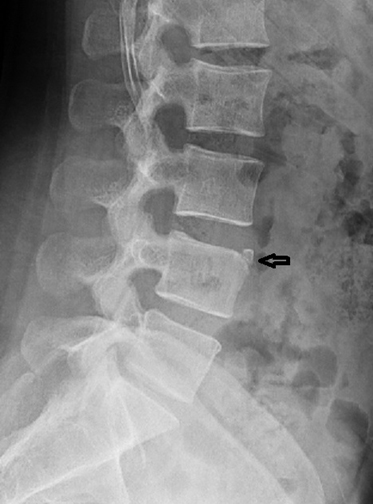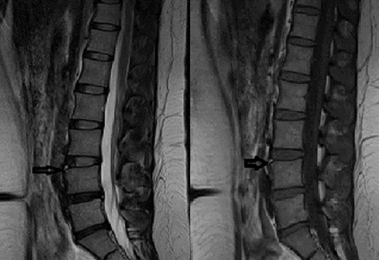Limbus Vertebra Presenting with Inflammatory Low Back Pain: A Case Report
Serpil Tuna1, Tayfun Özdemir2, Hande Ece Öz3
1 Faculty, Department of Physical Medicine and Rehabilitation, Medical Faculty, Akdeniz University, Turkey.
2 Faculty, Department of Physical Medicine and Rehabilitation, Medical Faculty, Akdeniz University, Turkey.
3 Faculty, Department of Physical Medicine and Rehabilitation, Medical Faculty, Akdeniz University, Turkey.
NAME, ADDRESS, E-MAIL ID OF THE CORRESPONDING AUTHOR: Dr. Serpil Tuna, Faculty, Department of Physical Medicine and Rehabilitation, Medical Faculty, Akdeniz University, Turkey.
E-mail: dr.serpiltuna07@hotmail.com
Limbus vertebra is a condition characterized by marginal interosseous herniation of the nucleus pulposus, and causes non specific symptoms like low back pain, back pain, muscle spasms and radiculopathy. It is frequently confused with vertebral fracture, infection, schmorl nodule or tumour because it has not a spesific symptom. It usually causes mechanical low back pain rather than inflammatory low back pain. We reported a patient presented with inflammatory low back pain and diagnosed with anterior limbus vertebra because it is rare and the patient has atypical clinical presentation.
Anterior limbus vertebra,Interosseous herniation,Radiculopathy
Case Report
A 29-year-old woman had worsening and buttock spreading low back pain for four mounths. She also describes one and half hour long morning stifness and night pain which awakes her from sleep. She said her low back pain had been increased after physical activity and also continues during rest.
She had a traffic accident when she was 6 and she has had relapsing low back pain periods since she had carried a heavy thing when she was 14. She has been also followed for hypothyroid and polycyctic over syndrome.
Her low back motions were painfull and her lomber flexion was limited on physical examination (lomber flexion:40°, extantion: 30°, lateral flexion: 25°)
She had paravertebral spasm and tenderness bilaterally. She had pain on right sacroilac joint compression . FABER and FADIR tests were positive on her right hip. Lomber Schober was measured as 15 cm. Her other joints and neurological examiantion (muscle strength, reflexes and sensory examination) were normal.
Laboratory findings were in normal range. Erythrocyte sedimentation rate was 10 mm/hour (normal range 0-20mm/hour), CRP was 0,03mg/dl (normal range 0-0,5) and RF was 10,7 (normal range 0-15U/ml). Chlamydia trachomatis IgG and IgM and brucella agglutination test were negative.
There was a sclerotic bone fragment placed anterosuperior of the 4th lomber vertebra on plain lumbar spine X-ray [Table/Fig-1]. Lumbosacral MR revealed hyperintense area placed anterosuperior part of the 4th lumbar vertebra [Table/Fig-2]. Sacroiliac MR was normal.
Lateral spine radiograph: Fragment sclerotik of the anterosuperior portion of the L4 vertebra.

Lumbosacral MRI; (A: T1-weighted image, B: T2-weighted image), also financed the hyperintense limbus fragment in T1 and T2 secance.

We treated patient with diclofenac sodium 150 mg /day, tizanidin 6mg/day for 2 weeks and suggested rest. Her syptoms improved after treatment.
Discussion
Limbus vertebra is a condition characterized by marginal interosseous herniation of the nucleus pulposus. It comes from a defect under the ring apophysis or in vertebral endplate during the skeletal development stage [1]. Limbus vertebra causes non spesific symptoms like low back pain, back pain, muscle spasms and radiculopathy. It is frequently confused with vertebral fracture, infection, schmorl nodule or tumour [2,3]. Although limbus vertabra is known for a long time patients may be misdiagnosed because it has not a spesific symptom and it is not well- known by physicians. Especially it should be kept in mind in patients with low back pain after a trauma [3].
There are limited cases with limbus vertebra in the literature by now and this cases are usually accompanied by mechanical low back pain. According to our literature search (pub med, web of science) there is not any limbus vertebra case presenting with spondyloarthritis sypmtoms.
We reported a patient presented with inflammatory low back pain and diagnosed with anterior limbus vertebra because it is rare and the patient has atypical clinical presentation.
Limbus vertabra is frequently localized at anterosuperior margins of mid lumbar verbra bodies but it also can be seen at the inferior and posterior margins and other vertebra levels [1]. It is thought that posterior limbus vertebra may cause nerve root compressions but anterior limbus vertebra is usually asymptomatic [3].
Limbus vertabra can be diagnosed by trianguler bone fragment image seen on the plain radiography but it may confused with vertebral fracture frequently. It should be considered that there is sclerotic margine of trianguler fragment apart from acute fracture on plane graphy [1]. Additionally, limbus vertebra may also be confused with schmorl nodule. Limbus vertebra is a marginal herniation despite schmorl nodule is a central herniation into the vertebral end plate [4]. Especially limbus vertebra at level L5-S1 may be overlooked because of superposition of pelvic structures. MR is the most sensitive diagnostic method for limbus vertebra diagnosis [2]. The limbus vertebra is often misdiagnosed as a fracture, infection or tumour which may result in unnecessary invasive procedures [1,3].
Limbus vertebra is usually diasgnosed incidently and usually doesn’t need treetment. Symptomatic patients are treated conservatively but if conservative treatment fails surgical treatment may be needed. Usually total laminectomy is necessery for sufficient excision of limbus fragment [2]. Some researchers also used different surgical techniques [5,6]. Akhaddar A et al., has suggested excision of the mobile fragment and quit the stable fragmant alone [7]. But some patients still have had pain after surgery in this method. Surgical treatment results are variable.
Conclusions
It should not be forgotten that limbus vertebra can be present with inflammatory low back pain symptoms and may be confused with spondyloarthropathy or malignancy. It is important to questionnare patient for trauma history and to remember limbus vertebra possibility to avoid unnecesarry diagnostic procedures and reaching the right diagnose quickly.
[1]. Yen Y, Wu FZ, Giant limbus vertebra mimicking a vertebral fracture QJM : monthly journal of the Association of Physicians 2014 107(11):937-38. [Google Scholar]
[2]. Huang PY, Yeh LR, Tzeng WS, Tsai MY, Shih TT, Pan HB, Imaging features of posterior limbus vertebrae Clinical imaging 2012 36(6):797-802. [Google Scholar]
[3]. Sanal HT, Yilmaz S, Simsek I, Limbus vertebra Arthritis and rheumatism 2012 64(12):4011 [Google Scholar]
[4]. Ghelman B, Freiberger RH, The limbus vertebra: an anterior disc herniation demonstrated by discography AJR American journal of roentgenology 1976 127(5):854-55. [Google Scholar]
[5]. Scarfo GB, Muzii VF, Mariottini A, Bolognini A, Cartolari R, Posterior retroextramarginal disc hernia (PREMDH): definition, diagnosis, and treatment Surgical neurology 1996 46(3):205-11. [Google Scholar]
[6]. Asazuma T, Nobuta M, Sato M, Yamagishi M, Fujikawa K, Lumbar disc herniation associated with separation of the posterior ring apophysis: analysis of five surgical cases and review of the literature Acta neurochirurgica 2003 145(6):461-66.discussion 6 [Google Scholar]
[7]. Akhaddar A, Belfquih H, Oukabli M, Boucetta M, Posterior ring apophysis separation combined with lumbar disc herniation in adults: a 10-year experience in the surgical management of 87 cases Journal of neurosurgery Spine 2011 14(4):475-83. [Google Scholar]